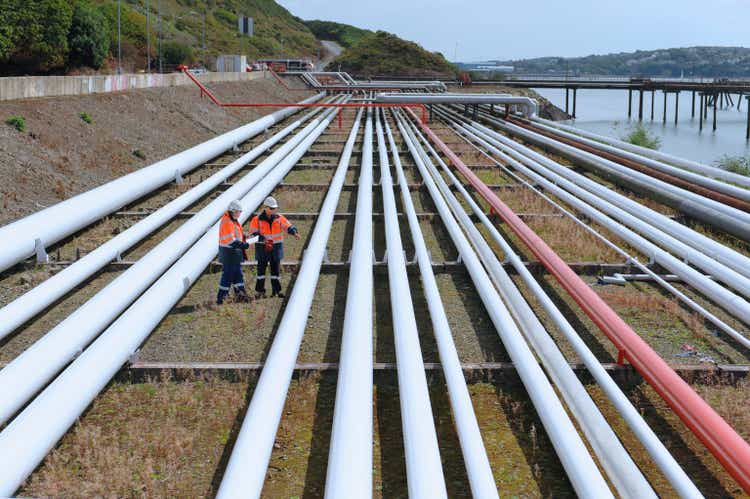
Jacobs Stock Photography Ltd Data center power, fueled by demand for artificial intelligence, is one of the scant few areas of hype in the energy markets nowadays. Data centers require constant, reliable power - and for all the benefits, renewable energy does not serve that purpose, at least not yet without advancements in battery technology. Power commissions have gotten a bit jumpy already when it comes to grid reliability, and many utilities are putting out plans to shore up power generation fueled by natural gas.
Put together with potential demand growth from other technologies (i.e., electric vehicles) and natural gas ( NG1:COM ) demand in the United States, once expected to be flat, now is expected to increase.

But how much demand, and when? That's the topic of exploration for today. Data Centers The amount of data centers has doubled over the past four years, with the count now standing at more than 5,500. By 2030, that figure is expected to double again.
Driving all of this is primarily artificial intelligence-powered tasks such as speech and image recognition, mapping, and generative AI. What makes all of this so interesting is that the spread of data centers is not uniform across the United States. Roughly half of data centers are located in just four states: Virginia, California, Texas, and Illinois.
Including the top ten states, the bias is clearly towards two power markets: PJM and ERCOT. FERC Currently, data centers use around 150 Terawatt hours per year, potentially doubling by 2030. This is around 10.
0% compound annual growth rate and requires a significant power grid expansion, nearly all of which will be needed in the ERCOT and PJM markets. To translate that to natural gas, let's assume (wrongly) that all of this will be served by combined cycle natural gas turbines. A typical heat rate is around 7.
4 mmbtu per megawatt hour, so if you run the math, this works out to 12.0 Bcf/d of potential additional natural gas demand needs. Even as recently as 2023, agencies like the EIA were predicting natural gas demand from the power sector to decrease consistently from now through 2050: In the AEO2023 Reference case, we project that natural gas consumption in the U.
S. electric power sector falls from 32.3 Bcf/d in 2022 to 21.
1 Bcf/d by 2050, driven by growth in renewable sources. Now, industry projections on the need for data center power could be too high, and we most definitely will not be using solely natural gas to meet those needs. But even if we discount the growth - call it 250 Twh/d by 2030 - and assume only half will be fueled by natural gas, that is 4.
0 Bcf/d necessary to fuel those plants. While that might not seem like a lot at first glance, keep in mind the delta between that growth and prior forecasts. It's equivalent to the demand from the Sabine Pass LNG facility.
That's no small potatoes - never mind any potential future growth from technological advancements that might impact the grid. Utilities Make Plans In Mid-Atlantic Adding more generation to the grid takes time, whether it be solar, wind, coal, or natural gas. Construction is a years-long process, and in the case of the PJM market where utilities are regulated monopolies, construction must be approved beforehand as utility ratepayers will bear the eventual cost of the construction (plus an allowed return on equity).
We've seen a lot of utilities come up with plans recently, particularly given the Mountain Valley Pipeline has officially been pulled over the finish line by Congress and can flow gas to the region. It didn't make too much sense to develop plans inclusive of natural gas without knowing whether the pipeline would be operational. Dominion Energy ( D ) serves several key states when it comes to data centers, notably Virginia, which is by far the largest when it comes to power load and future development.
In its most recent integrated resource plan ("IRP"), projections were for growth of 10,000 MW in peak power demand within their service footprint by 2038, with the majority of that growth expected to be driven by data centers over the fifteen-year planning period. Natural gas is already the cornerstone of power generation for Dominion Energy in Virginia, with the rest tied to coal and nuclear and a growing solar business. The tricky business is that the Virginia Clean Economy Act set goals for renewables and onshore wind that are, even among analysts with a clean energy slant, aspirational.
Power derived from fossil fuels are heavily discouraged, and Dominion is mandated to be wholly renewable by 2045. Idealistically, natural gas fired generation would switch to being hydrogen fired by that date, but the infrastructure to support that is arguably more elusive than long-lasting battery storage. As readers likely know, that's just unattainable given current technology.
And while battery storage advancements might make it one day attainable, it's hard to set a framework banking on technology that does not exist. So, Dominion Energy pitched a "Plan B" proposal, which called for varying amounts of natural gas fired generation being built as well as new solar, wind, and energy storage. Dominion Energy stated that more natural gas fired capability (between 3,000 - 5,000 MW) would strike the best balance in the interim.
The public utility commission ("PUC") denied their requests and Dominion Energy was sent back to the drawing board to develop a new IRP, but odds are eventually that the PUC will be forced to approve something. Alternatively, data centers could decide to build their own on site generation, and be "behind the grid". This cuts out the PUC and Dominion entirely, but brings with it its own regulatory headaches.
Nonetheless, pushback could be less in this way. But regardless, it seems likely that new natural gas fired generation will be built in Virginia in some capacity over the next several years. Duke Energy ( DUK ) serves North and South Carolina, and while not key states, they do have a presence.
A proposed settlement was reached regarding their own IRP filed back in November 2023 that, you guessed it, forecast a heck of a lot of incoming demand growth over the next several years. State regulators do need to approve, but it has gotten past staffers that would inevitably kill an IRP that had no chance. Under that settlement, Duke Energy will build seven new combined cycle and combustion turbines by 2031.
In total, this would be 7,300 MW of power - significantly more than they had pitched a couple of years ago. They also wanted to reserve the right to build another three combined cycle plants totaling 2,700 MW early on in the 2030s. That's a massive amount of natural gas additions, so they will have to provide how they exactly will source all this gas at the next PUC meeting.
Mountain Valley and its planned extensions are a key source of that, as well as additional extensions off of Transco (Mountain Valley now part of EQT Corporation ( EQT ), Transco a part of Williams ( WMB )). Texas Tries To Address Its Own Issues While this has less to do with data centers directly and more to do with solving power scarcity, Texas has notably had its own issues with grid reliability. Unlike the above markets, Texas is an unregulated power market, meaning that there are multiple companies that compete to provide power.
Some of those companies have customer-facing operations, others are solely merchant power producers that sell wholesale to buyers on the grid. Most electricity produced in the states is governed by ERCOT, which sets the framework under which these companies compete. Despite all of the political hand-wringing when it comes to talking about states like Texas, renewable capability has increased significantly in the ERCOT.
Texas is the largest producer of wind power in the United States, and is second when it comes to solar. It is by no means a fossil fuel playground when it comes to power production, and rising costs to comply with environmental regulations plus a production tax credit for renewable sources of power has pushed many legacy coal and natural gas plants into retirement. Texas voters late last year approved an amendment that would create the Texas Energy Fund.
Of the ten billion dollars included in that, nearly three quarters would go towards helping develop new gas fired generation in the state, with the rest going towards microgrids and grid modernization and weather proofing. The Performance Credit Mechanism ("PCM") was also approved and is still being finalized. It's a complicated structure, but the end result of that is that electricity producers will essentially be guaranteeing that they will have load available at certain times when electricity is forecast to be scarcest - and that's something that baseload power like natural gas will have a far easier time doing than solar or wind.
This should, in theory, provide revenue to baseload power to help capacity remain online in order to serve markets when the need is most great. Takeaways There is a critical role for natural gas to likely play in meeting the growing power demands of data centers, particularly in regions like PJM and ERCOT, where the concentration of data centers is highest. Despite the push towards renewable energy, the current technological limitations of battery storage and the intermittent nature of renewables make natural gas an essential component of reliable power generation.
The projections of substantial growth in data center power demand, coupled with the need for grid reliability and the slow pace of renewable infrastructure development, suggest that natural gas demand may not only remain stable but could also see significant growth. Utilities clearly recognize this, and it is high time that PUCs and politicians recognize that importance and approve these plans so that we don't end up in a situation where brown-outs, which have already become more common place in some states, do not become more frequent. Are you an investor looking for quality research within the oil and gas industry? Energy Investing Authority is the source.
While commodity prices are up and so too are shareholder dividends, it can be easy to chase yield and buy the wrong firms. Income investors cannot afford those mistakes. Deep dive analysis forms the foundation of the platform.
Hundreds of companies fall under the coverage universe, from pipelines to renewables to producers. Receive actionable research to keep your portfolio outperforming benchmarks - the EIA portfolio has done so six out of the past seven years. Sign up for a NO OBLIGATION FREE TRIAL today! Michael Boyd is an energy specialist with a decade of experience in both the investment advisory and investment banking spaces, with stints in portfolio management, residential mortgage-backed securities, derivatives, and internal audit at various firms.
Today, he is a full-time investor and "independent analyst for hire.” Michael leads the Investing Group Energy Investing Authority . The service focuses on finding total return opportunities within the energy sector, ranging from upstream producers to pipelines to refineries.
Features include: model portfolios, real time trade alerts, high quality research, and an active and vibrant chatroom of professional investors. Learn More . Analyst’s Disclosure: I/we have no stock, option or similar derivative position in any of the companies mentioned, and no plans to initiate any such positions within the next 72 hours.
I wrote this article myself, and it expresses my own opinions. I am not receiving compensation for it (other than from Seeking Alpha). I have no business relationship with any company whose stock is mentioned in this article.
Seeking Alpha's Disclosure: Past performance is no guarantee of future results. No recommendation or advice is being given as to whether any investment is suitable for a particular investor. Any views or opinions expressed above may not reflect those of Seeking Alpha as a whole.
Seeking Alpha is not a licensed securities dealer, broker or US investment adviser or investment bank. Our analysts are third party authors that include both professional investors and individual investors who may not be licensed or certified by any institute or regulatory body..














